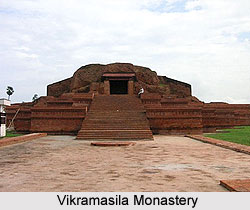 Vikramasila Monastery is one of the most popular monasteries in Antichak in the Bhagalpur District of Bihar. This ancient site serves as a great centre of Vajrayana Buddhism and of learning. Vajrayana form of Buddhism was established in Tibet in the 11thcentury AD. The monastery comprises of a large complex of buildings including some excellent temples and stupas. In 11th century, during the reign of King Rampala, the monastery was an important centre of learning, which used to house around 160 teachers and 1000 students.
Vikramasila Monastery is one of the most popular monasteries in Antichak in the Bhagalpur District of Bihar. This ancient site serves as a great centre of Vajrayana Buddhism and of learning. Vajrayana form of Buddhism was established in Tibet in the 11thcentury AD. The monastery comprises of a large complex of buildings including some excellent temples and stupas. In 11th century, during the reign of King Rampala, the monastery was an important centre of learning, which used to house around 160 teachers and 1000 students.
History of Vikramasila Monastery
A number of monasteries grew up during the Pala period in ancient Bengal and Magadha region. According to Tibetan sources, five great Mahaviharas stood out, which were Vikramashila, Nalanda, Somapura, Odantapura and Jagaddala. These five monasteries formed a network, which was operated by the state administration and there was a setup for coordinating with each other.
Vikramashila Monastery was founded by Pala king Dharmapala in the late 8th or early 9th century. The monastery prospered for about four centuries; then around 1193, it got destroyed by Bakhtiyar Khilji along with the other major centers of Buddhism in India. Tibetan sources anticipate the story of Vikramasila, especially the writings of Taranatha, who was a Tibetan monk historian of the 16th-17th centuries.
Excavations of Vikramasila Monastery
The site of Vikramasila was excavated in 1960-69 by B.P. Sinha of Patna University. The excavation has shown three levels of activity on the same site between 9th to 13th centuries.
The excavation has revealed the huge square Vikramasila Monastery with a cruciform stupa in its centre, a library building and cluster of votive stupas. To the north of the monastery, a number of scattered structures including a Tibetan and a Hindu temple have been found. The monastery has fort-like projections on its outer wall. This excavation covers an area of about 100 acres.
The Vikramasila monastery, or residence of the Buddhist monks, is a huge square structure, each side measuring 330 meters having a series of 208 cells. A few brick arched underground chambers under some of the cells have also been noticed which were probably meant for confined meditation by the monks.
The main stupa built for the sake of worship is a brick structure laid in mud mortar which stands in the centre of the Vikramasila monastery. This two-terraced stupa is cruciform and about 15 meters high from the ground level, which is accessible through a flight of steps on the north side. On each of the four cardinal directions there is a protruding chamber with a pillared antechamber and a separate pillared mandapa in front. In the four chambers of the stupa, there were placed colossal stucco images of seated Lord Buddha of which three were found in situ but the remaining one on north side was possibly replaced by a stone image after the clay image was somehow damaged.
On the south west portion of the monastery, there is a rectangular structure identified as a library building. It was air-conditioned by cooled water of the adjoining reservoir through a range of vents in the back wall. The system was perhaps meant for preserving delicate manuscripts.
Visiting Information to Vikramasila Monastery
This site is approachable from Kahalgaon city, which is about 13 km from the site. Kahalgaon can be reached via NH-80 at Anadipur. River cruises are also available from Kolkata, West Bengal to Varanasi, Uttar Pradesh to reach the Vikramasila site.



















